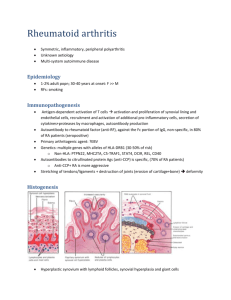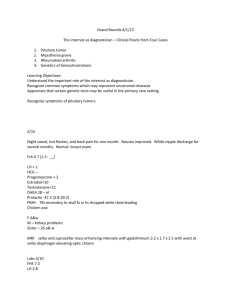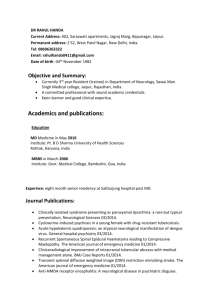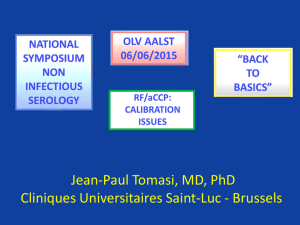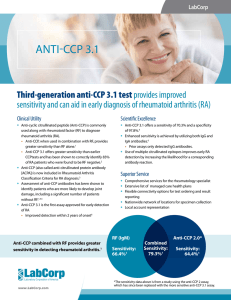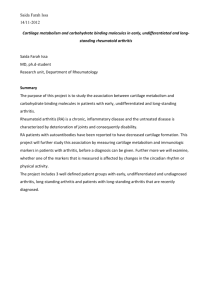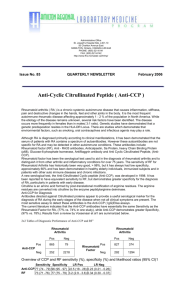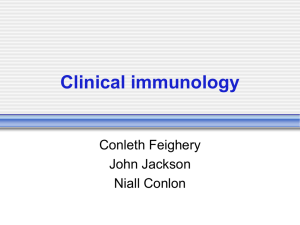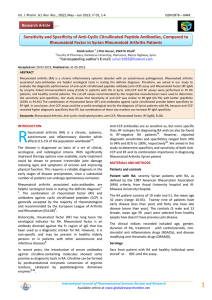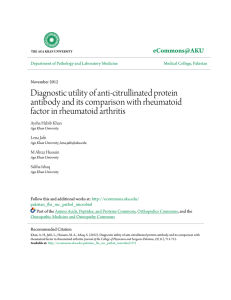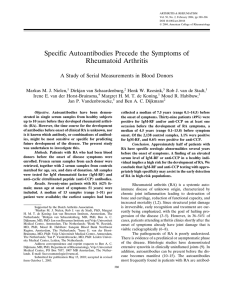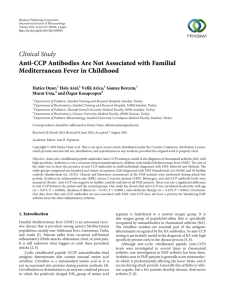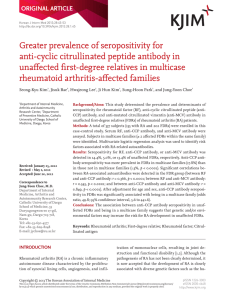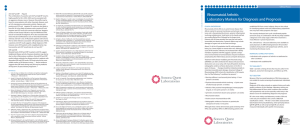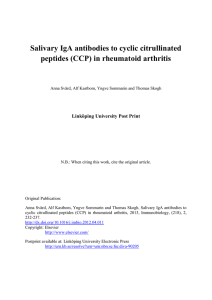CCP Antibodies for Rheumatoid Arthritis
advertisement
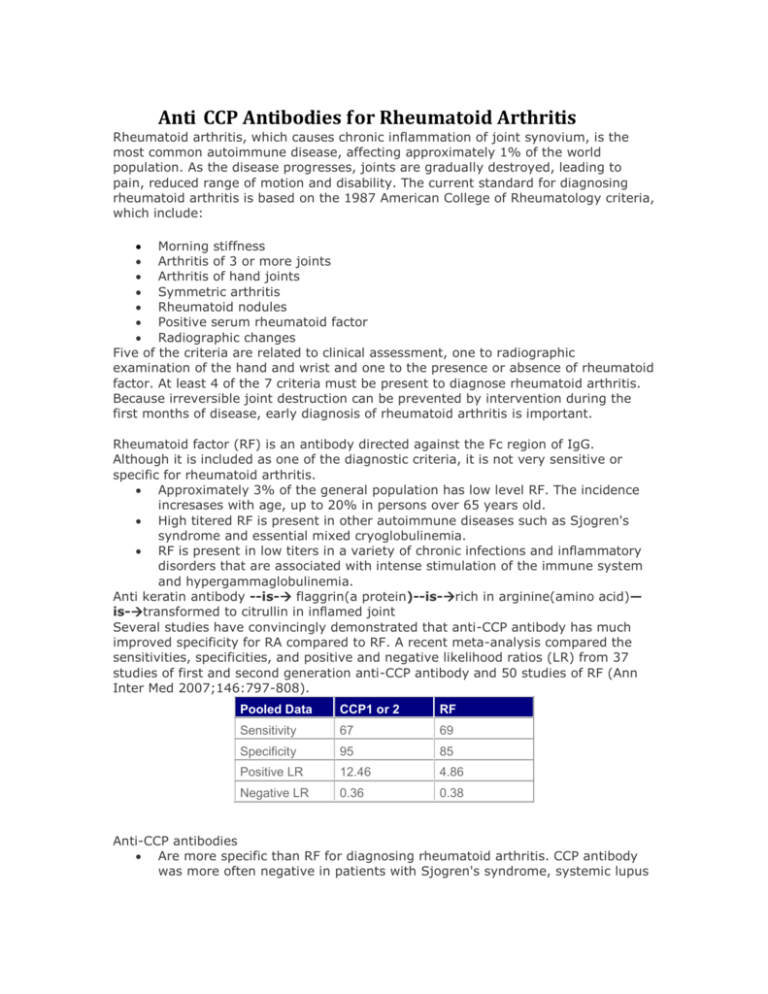
Anti CCP Antibodies for Rheumatoid Arthritis Rheumatoid arthritis, which causes chronic inflammation of joint synovium, is the most common autoimmune disease, affecting approximately 1% of the world population. As the disease progresses, joints are gradually destroyed, leading to pain, reduced range of motion and disability. The current standard for diagnosing rheumatoid arthritis is based on the 1987 American College of Rheumatology criteria, which include: Morning stiffness Arthritis of 3 or more joints Arthritis of hand joints Symmetric arthritis Rheumatoid nodules Positive serum rheumatoid factor Radiographic changes Five of the criteria are related to clinical assessment, one to radiographic examination of the hand and wrist and one to the presence or absence of rheumatoid factor. At least 4 of the 7 criteria must be present to diagnose rheumatoid arthritis. Because irreversible joint destruction can be prevented by intervention during the first months of disease, early diagnosis of rheumatoid arthritis is important. Rheumatoid factor (RF) is an antibody directed against the Fc region of IgG. Although it is included as one of the diagnostic criteria, it is not very sensitive or specific for rheumatoid arthritis. Approximately 3% of the general population has low level RF. The incidence incresases with age, up to 20% in persons over 65 years old. High titered RF is present in other autoimmune diseases such as Sjogren's syndrome and essential mixed cryoglobulinemia. RF is present in low titers in a variety of chronic infections and inflammatory disorders that are associated with intense stimulation of the immune system and hypergammaglobulinemia. Anti keratin antibody --is- flaggrin(a protein)--is-rich in arginine(amino acid)— is-transformed to citrullin in inflamed joint Several studies have convincingly demonstrated that anti-CCP antibody has much improved specificity for RA compared to RF. A recent meta-analysis compared the sensitivities, specificities, and positive and negative likelihood ratios (LR) from 37 studies of first and second generation anti-CCP antibody and 50 studies of RF (Ann Inter Med 2007;146:797-808). Pooled Data CCP1 or 2 RF Sensitivity 67 69 Specificity 95 85 Positive LR 12.46 4.86 Negative LR 0.36 0.38 Anti-CCP antibodies Are more specific than RF for diagnosing rheumatoid arthritis. CCP antibody was more often negative in patients with Sjogren's syndrome, systemic lupus erythematosis with erosive arthritis, polymyalgia rheumatica and hepatitis C infection presenting with joint complaints than RF. RF is detectable in 40 to 70% of patients with these conditions, but CCP is detectable in < 10%. The current CCP3 assay has higher sensitivity than the first and second generation assays that were included in this meta-analysis. Another conclusion of the meta-analysis was that the risk for radiographic progression was greater with anti-CCP antibody positivity than with RF positivity. Earlier diagnosis of rheumatoid arthritis facilitates earlier treatment with disease-modifying antirheumatic drugs (DMARDS). The authors of the meta-analysis concluded that positivity for anti-CCP antibodies should be added to the American College of Rheumatology criteria for diagnosis of rheumatoid arthritis. Currently, most rheumatologists measure both anti-CCP antibody and RF to comply with American College of Rheumatology guidelines and to maximize sensitivity. However, RF may become obsolete in the future if the anti-CCP antibody is added to the guidelines and the third generation anti-CCP antibody assay is confirmed to have higher sensitivity than RF. Reference Values <20.0 U (negative) 20.0-39.9 U (weak positive) 40.0-59.9 U (positive) > or =60.0 U (strong positive) Reference values apply to all ages. Cautions Positive results for cyclic citrullinated peptide (CCP) antibodies may occur in some patients with systemic lupus erythematosus or other autoimmune, connective tissue diseases. In the Mayo study mentioned above, the false-positive rate in this subgroup was approximately 10%. Antirheumatic therapy should not be initiated based solely on a positive test for CCP antibodies, and changes in treatment should not be based upon the levels of CCP antibodies. Specimen Type Serum Container/Tube: Plain, red top or serum gel Specimen Volume: 0.5 mL Reject Due To Specimens other than Serum Hemolysis Mild OK; Gross reject Lipemia Mild OK; Gross reject Icteric Mild OK; Gross OK Transport Temperature Refrig\Frozen OK\Ambient NO




